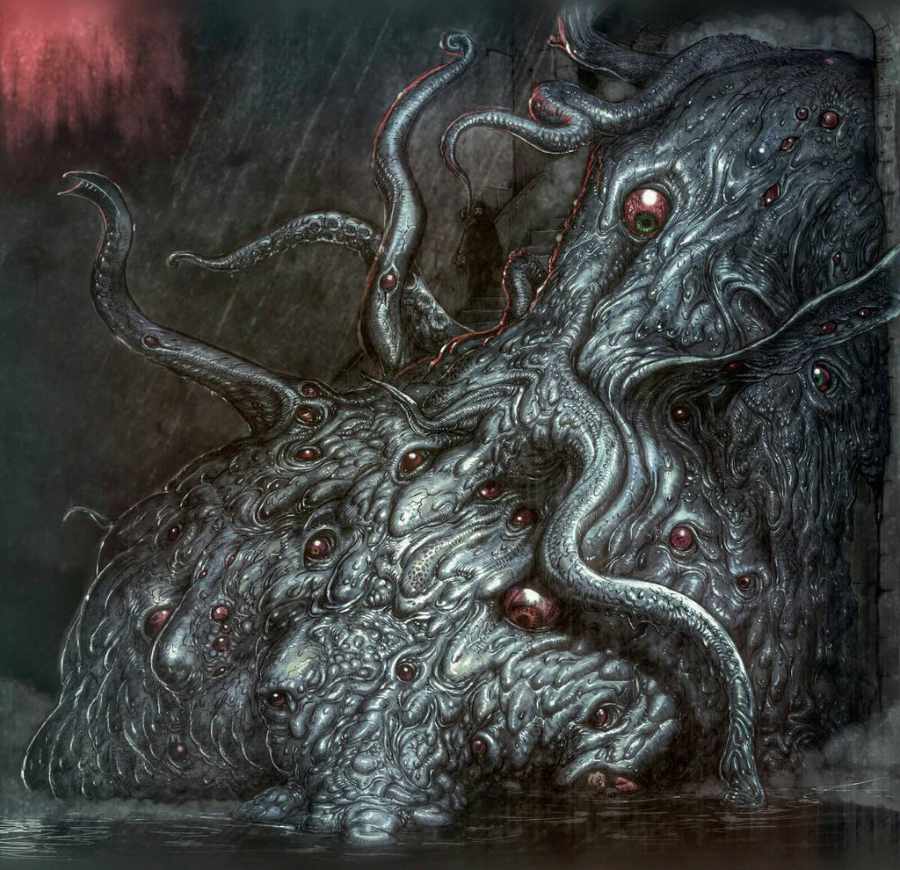A shoggoth is a being mentioned in passing in H. P. Lovecraft’s sonnet cycle Fungi from Yuggoth (1929–30) and later described in detail in his novella At the Mountains of Madness (1931). “It was a terrible, indescribable thing vaster than any subway train—a shapeless congeries of protoplasmic bubbles, faintly self-luminous, and with myriads of temporary eyes forming and un-forming as pustules of greenish light all over the tunnel-filling front that bore down upon us, crushing the frantic penguins and slithering over the glistening floor that it and its kind had swept so evilly free of all litter.” Lovecraft describes them as massive amoeba-like creatures made out of iridescent black slime, with multiple eyes “floating” on the surface. They are “protoplasmic”, lacking any default body shape and instead being able to form limbs and organs at will. A typical shoggoth measures 15 feet across when a sphere, though the story mentions the existence of others of much greater size. Being amorphous, shoggoths can take on any shape needed, making them very versatile within aquatic environments. The shoggoths bear a strong physical resemblance to Ubbo-Sathla, a god-like entity supposedly responsible for the origin of life on Earth in the Hyperborean cycle written by Clark Ashton Smith. Shoggoths were initially used to build the cities of their masters, the Elder Things. Though able to “understand” the Elder Things’ language, shoggoths had no real consciousness and were controlled through hypnotic suggestion. Over millions of years of existence, some shoggoths mutated, developed independent minds, and rebelled. The Elder Things succeeded in quelling the insurrection, but exterminating the shoggoths was not an option as the Elder Things were dependent on them for labor and had long lost their capacity to create new life. Shoggoths also developed the ability to survive on land, while the Elder Things retreated to the oceans. Shoggoths that remained alive in the abandoned Elder Thing city in Antarctica would later poorly imitate their masters’ art and voices, endlessly repeating “Tekeli-li” or “Takkeli”, a cry that their old masters used.
| Alias Shoggoth |
| Real Names/Alt Names N/A |
| Characteristics Pulp Characters, Weird Tales Universe, Giant, Monster Mash, Super Strength, Prehuman Epoch |
| Creators/Key Contributors H. P. Lovecraft |
| First Appearance “At the Mountains of Madness” in Astounding Stories (Feb-Apr 1936) |
| First Publisher Popular Publications [Internet Archive] [LUM] |
| Appearance List “At the Mountains of Madness” in Astounding Stories (Feb-Apr 1936). Variation on aliens in “Fungi from Yuggoth” (1929–30). |
| Sample Read At the Mountains of Madness [Standard eBooks] |
| Description A shoggoth is a being mentioned in passing in H. P. Lovecraft’s sonnet cycle Fungi from Yuggoth (1929–30) and later described in detail in his novella At the Mountains of Madness (1931). “It was a terrible, indescribable thing vaster than any subway train—a shapeless congeries of protoplasmic bubbles, faintly self-luminous, and with myriads of temporary eyes forming and un-forming as pustules of greenish light all over the tunnel-filling front that bore down upon us, crushing the frantic penguins and slithering over the glistening floor that it and its kind had swept so evilly free of all litter.” Lovecraft describes them as massive amoeba-like creatures made out of iridescent black slime, with multiple eyes “floating” on the surface. They are “protoplasmic”, lacking any default body shape and instead being able to form limbs and organs at will. A typical shoggoth measures 15 feet across when a sphere, though the story mentions the existence of others of much greater size. Being amorphous, shoggoths can take on any shape needed, making them very versatile within aquatic environments. The shoggoths bear a strong physical resemblance to Ubbo-Sathla, a god-like entity supposedly responsible for the origin of life on Earth in the Hyperborean cycle written by Clark Ashton Smith. Shoggoths were initially used to build the cities of their masters, the Elder Things. Though able to “understand” the Elder Things’ language, shoggoths had no real consciousness and were controlled through hypnotic suggestion. Over millions of years of existence, some shoggoths mutated, developed independent minds, and rebelled. The Elder Things succeeded in quelling the insurrection, but exterminating the shoggoths was not an option as the Elder Things were dependent on them for labor and had long lost their capacity to create new life. Shoggoths also developed the ability to survive on land, while the Elder Things retreated to the oceans. Shoggoths that remained alive in the abandoned Elder Thing city in Antarctica would later poorly imitate their masters’ art and voices, endlessly repeating “Tekeli-li” or “Takkeli”, a cry that their old masters used. |
| Source Shoggoth – Wikipedia |


